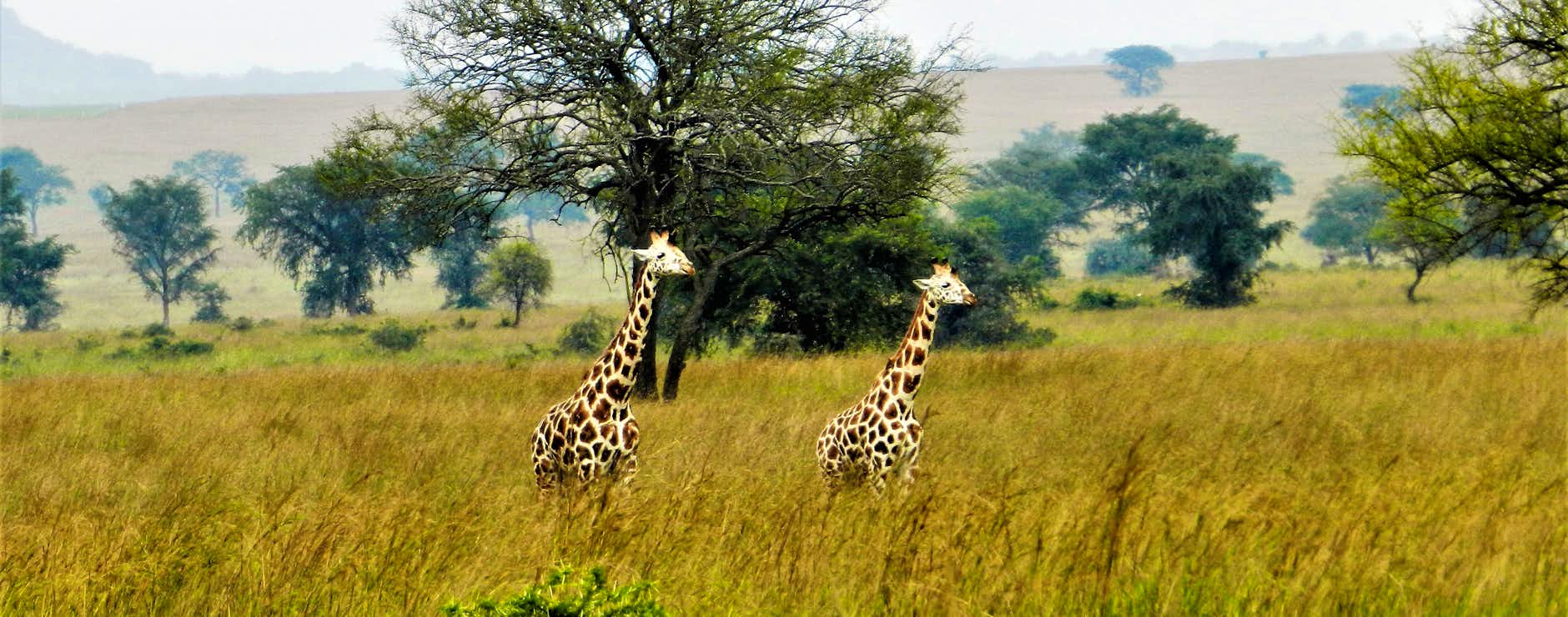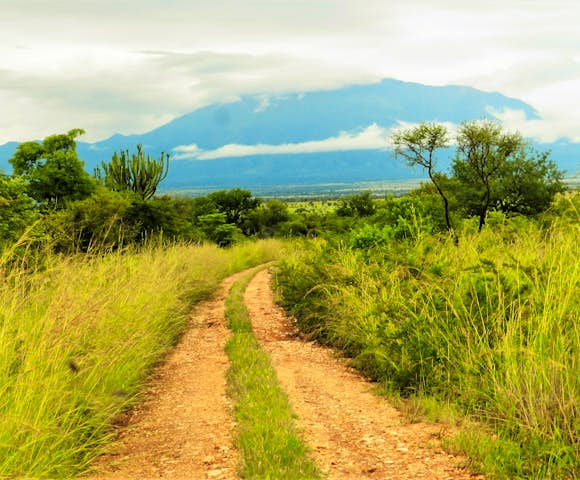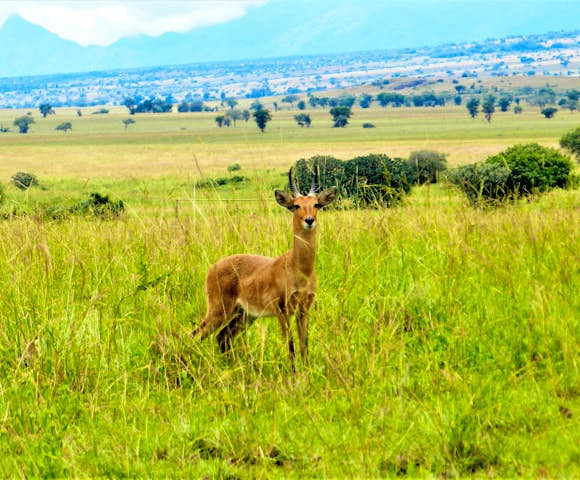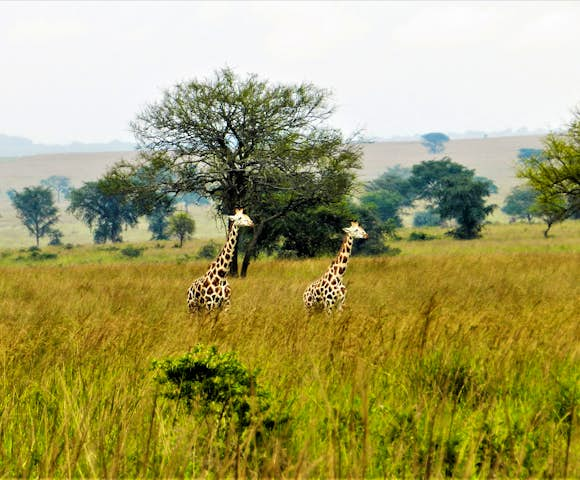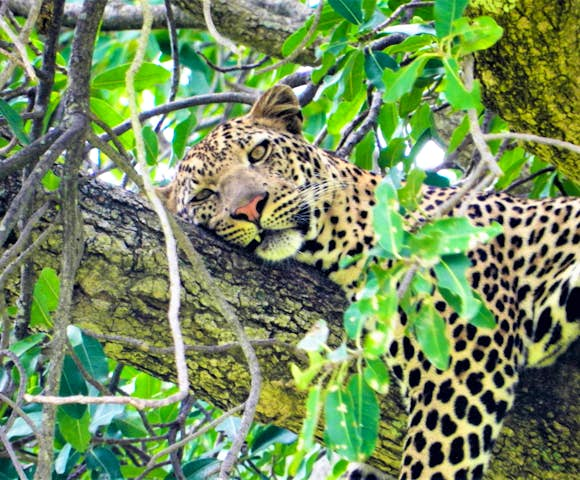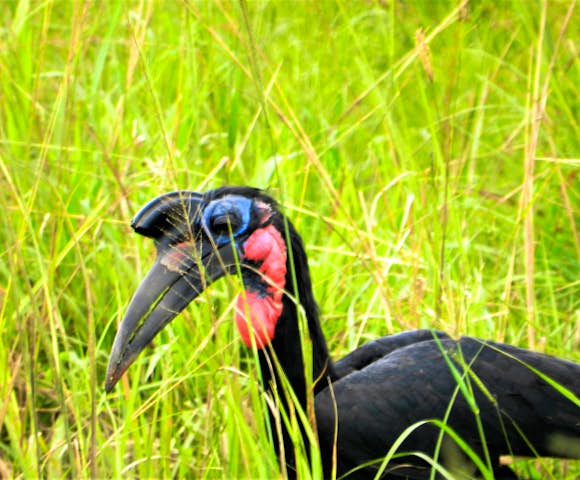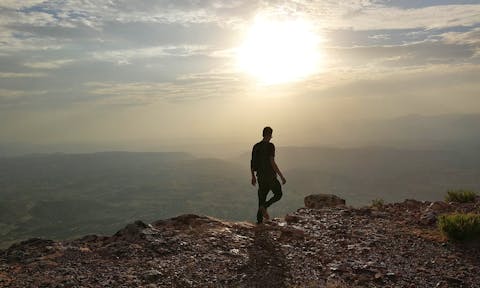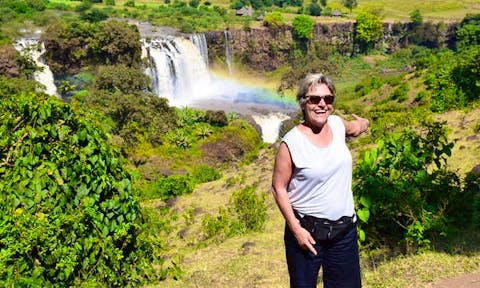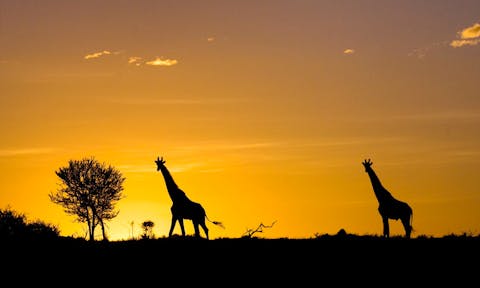Guide to Kidepo Valley National Park
Contents of our Guide

Leopard escaping the Kidepo Valley sun.
1. Introduction to Kidepo Valley National Park
Located in the distant north-east of Uganda, close by the borders of South Sudan and Kenya, Kidepo is an enthralling place of semi-arid savanna, seasonal rivers and low mountains. It is beautiful - and accessible - at any time of year.
Kidepo Valley National Park’s landscape extends across 1,442km². Altitudes range from 914m above sea level on the valley floor to the 2,750m peak of Mount Morungole which dominates the horizon.
The Kidepo and Narus rivers glide through the savannah landscape in the rainy season and disappear in the dry season. Kidepo’s remote location makes it Uganda’s most isolated national park. The low number of visitors has preserved the unique ambience of this untouched wilderness.
Cut off for years by conflict of varying forms, it has only recently become accessible by both road and air. Currently, there are only two lodges and a government rest camp available. These two factors, along with the relatively high cost of reaching the park, have combined to keep visitor numbers low. But those who do make it are in for a treat, with enjoyment only amplified by the fact you are well off the beaten track, miles from anywhere.

Volcanic ranges border Kidepo and provide an epic backdrop.
2. Getting There
By road: Most visitors drive from Murchison Falls which takes 7 hours or less on the sealed road. Some visitors choose to break up the journey by spending a night near Sipi Falls. Kampala is located 571km from Kidepo. The 10-hour drive from Kampala via Gulu and Kitgum is a demanding journey and few people choose this route.
By air: Kidepo is serviced by a couple of light aircraft companies flying into the airstrip close to Apoka. These flights only operate on certain days and require a guaranteed number of passengers to fly, making the flight expensive for couples or small groups travelling on their own, but is not so bad for families or larger groups. Don’t let it put you off though: there is something very special about flying out of Entebbe, circling over the drama of Murchison Falls, before pressing on to the expanse of Kidepo.

3. Wildlife in Kidepo
Kidepo is Uganda’s third largest national park, and only Queen Elizabeth National Park contains greater biodiversity.
Kidepo is home to 77 mammal species and the park offers great opportunities for game viewing. 20 species of predator are present, including lion, leopard, and spotted hyena.
In Uganda, black-backed jackal, bat-eared fox, aardwolf, cheetah, and caracal are endemic to Kidepo. The elephant population is over 650 (up from 200 in the mid ‘90s), buffalo are estimated to exceed 10,000, and there are over 50 Rothschild’s giraffes, an internationally important population.
Zebra graze on the plains and both greater and lesser kudu roam around the thick bush. Fortunate adventurers may even see a white-eared kob, more commonly seen in South Sudan and Ethiopia.
The bird list currently numbers 470 species. 60 of these are recorded in no other national park in Uganda. East Africa’s population of Clapperton’s francolin and the rose-ringed parakeet are found only in Kidepo. There are 56 species of raptor, and the park’s vultures are thriving. Kidepo is also the only place in Uganda where bird enthusiasts can encounter the majesty of the Common Ostrich.
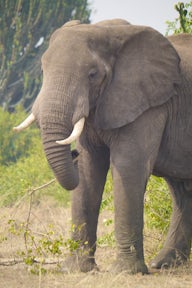
4. When to Visit
Kidepo is accessible all year round. However, its general climate does differ from the rest of Uganda. While June used to be a dry month, it is now accepted that a long rainy season will run from April to the end of November. This is not an eight-month deluge, but you can expect some rain most days.
The dry season runs from December to March. The temperatures soar during this time, often reaching 40 degrees Celsius. The middle and end of the dry season (November to February) offers higher chances of wildlife sightings since the park’s sandy soils cannot hold water, and it becomes arid.
During these months, the reduced availability of water sources causes animals to congregate around reliable water holes, increasing the chances of sightings. This is also the best chance to see cheetah hunting on the short grass plains.
In contrast, animals are more difficult to locate during the wet season (April to August) since they leave the valleys for higher ground, where sightings are lower.
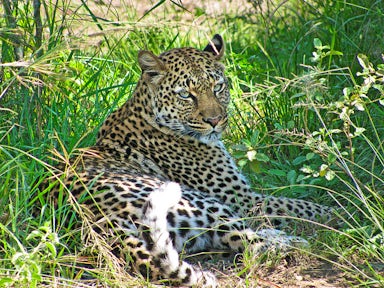
Big cats appear alongside big game on a single day of safari.
5. Game Drives
The quintessential African safari experience
Apoka game drives are the best way to explore the far reaches of the park within a short space of time. Coming face to face with large mammals and predators from the safety of your vehicle is an unforgettable experience.
Most drives follow two 20-kilometre routes through the wildlife-rich Narus Valley. Here, a small amount of water remains even in the dry season, attracting large buffalo herds, thirsty elephants, and antelope. A gathering of herbivores attracts predators, allowing you to see a range of beautiful animals.
In the hot, dry season, game drives depart in the early morning and late afternoon. This allows you to witness the animals in their most active state and capture memories when the light is best for photography.
The drier Kidepo Valley has less wildlife, but it has a wild beauty and is well worth discovering. Use the Kanagorok hot springs, 30 kilometres north of Apoka, as your focus, but do not get blinkered. Drive slowly, crossing the Kidepo River - a wide sand bed in the dry season - and meander across plains framed by the mountains. This is the best place for ostrich and secretary bird, while kudu enjoy the protection of the thicker bush.

Kidepo is the second most bio-diverse place in Uganda.
6. Wildlife Walks
Step out into the wild savannah, leaving the grumbling engine behind
Step out on a trail and notice the sense of vulnerability that makes every walk a vivid experience. Comforted by the knowledge of your guide, you can encounter the wilderness in all its glory.
Most of the walking trails take 2 to 3 hours and wind their way through the Narus Valley. The walk through the Narus Valley is very popular as its short 5km radius is comfortable for most visitors. It gives you ample opportunity to see an abundance of magnificent mammals and birds within the backdrop of a stunning landscape.
Birders will often patrol the fringes of the Narus and Namamukweny Valleys looking for the Abyssinian Roller, Purple Heron, Abyssinian Ground Hornbill, and Clapperton’s Francolin, which is found only in Kidepo.
For those looking for a greater challenge, a 15-kilometre route follows the ridge line into the hills. While there are many possible trails, some may not have been walked for a long time and will be temporarily closed.

Kidepo Cultural Encounters
-
Karamojong
The Karamojong are an ethnic group of Nilotic language speaking, cattle loving nomadic agro-pastoralists who migrated into what is now north-eastern Uganda from Ethiopia over 500 years ago. Like their counterparts in northern Kenya and south-western Ethiopia, the Karamojong have largely resisted the onset of modernity (although that is beginning to change) and still live traditional lives little changed from the time of their first arrival.
The community’s love of cattle has resulted in disputes over livestock and conflict has long been a part of Karamojong culture. This took on a more sinister edge as assault rifles became widely available following the end of the Amin regime, temporarily making the area off-limits to outsiders. However, since the withdrawal of Joseph Kony and the Lord’s Resistance Army from northern Uganda in 2005, and the de-militarisation of Karamoja by the Ugandan government in 2011, the area is now both safe to visit and welcoming to tourists.
The park deprived the Dodoth Karamojong of their traditional grazing and foraging grounds. It is therefore not only interesting to visit the Karamojong to learn about their culture, but also essential to ensure you are travelling sustainably. This ensures that the Karamojong directly benefit from tourism.
-
Ik Treks
The Ik people suffered most from the creation of the park. Thought to have been the first arrivals of the Ethiopian migration, the Ik were initially pastoralists who lost their cattle to Karamojong, Turkana, and Pokot raiders. Resorting to a hunter-gatherer lifestyle on the lower slopes of the Morungole Mountains, they were ejected from the park in 1962. The only option available to them was to attempt subsistence farming high up in the mountains outside the park borders.
Coinciding with a time of wide-spread famine known as ‘the time of one cup’, the movement pushed the Ik to the very edge of existence, pushing traditional social practices to breaking point and turning the Ik into a dark shadow of their former selves. It was during this time in the 1960s that the anthropologist Colin Turnbull lived for three years with the Ik, recording the collapse of their community and how the group members resorted to self-interest in the most horrific of ways. He told the story in the book ‘The Mountain People,’ which caused outrage at the time of publication.
Although Turnbull suspected that his experiences of the Ik were a partial result of their expulsion from the park, he did not fully grasp the impact of the trauma. Turnbull missed the point that increasing prosperity - not just survival - would enable the Ik to restore kinder, more expected, human customs.
The Ik still live a marginal life in the Morungole Mountains, but they have recovered from their troubles in recent decades. They welcome guided treks made by visitors eager to explore the landscape they inhabit and to understand a little more about their unique way of life.
This is not voyeuristic tourism. It is a difficult trek, both physically and mentally due to the questions that it raises about human rights, sustainable conservation, and human development. But with fees from the trek going to Ik community initiatives and interest from the outside world going some way to protecting the people from neighbourly threat, it is a compelling experience. It is also a beautiful trek.
Two different routes are available, depending on local weather conditions and your level of fitness.
9. Accommodation Options in Kidepo
Kidepo Savannah Lodge
Kidepo has just two small tourist lodges. Kidepo Savannah Lodge is a simple, but comfortable lodge located 500 metres from the Kalokudo Gate to Kidepo.
There are nine ‘tents’ that use one ablution block and eight self-contained ‘safari tents’ all leading off from a central dining area and bar.
The position provides tourists with great views of the Narus Valley and the mountains beyond.
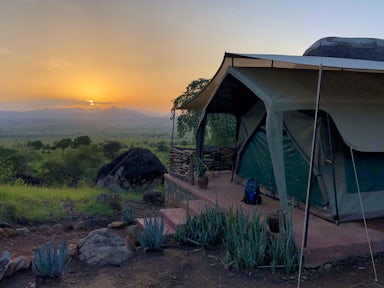
A campsite with a view
Apoka Safari Lodge
Apoka Safari Lodge is a luxury lodge perfectly located on a low rise in the middle of the plains.
Wildlife is everywhere. Whether you see zebra or buffalo just outside your room when the grass is high, or lion lazing by the pool in the dry months, you are in a prime position to appreciate the wilderness in all its glory.
10 spacious bandas made from wood, canvas, and thatch provide comfortable accommodation. The dining room and bar is marvellous: thatch-roofed with a raised platform that is perfect for wildlife viewing. There is also a high observation tower, which also doubles as an unforgettable private breakfast spot.
10. Popular Trips to Kidepo Valley
The tours below showcase just some of what is possible. Use these itineraries as starting points, or to draw inspiration. Then get in touch, and let our expert team help craft the perfect itinerary for you.
How Can We Help You?
We love helping people plan adventures to Uganda, and with a network of local partners and years of experience, we can help you decide when to travel, where to go and what to see.

Brilliant says
Located in the Karamoja region of north-east Uganda, Kidepo Valley National Park is the second most bio-diverse park in Uganda. A combination of alluring wildlife and a stunning landscape makes Kidepo the ultimate destination for the adventurer.
Thinking about visiting Uganda?
Listen
We'll spend some time listening to your aspirations, then discuss the kind of experience that might suit you.
Match
Next we'll discuss the options, shortlist the best trips for you and present you our impartial recommendations.
Reserve
We'll place a 24 hour hold on your preferred option - without obligation - whilst we talk through the details.
Get in touch and we can help you understand your options, design an itinerary that's right for you, and then get you set up and ready to go.
+1 315 645 2889

